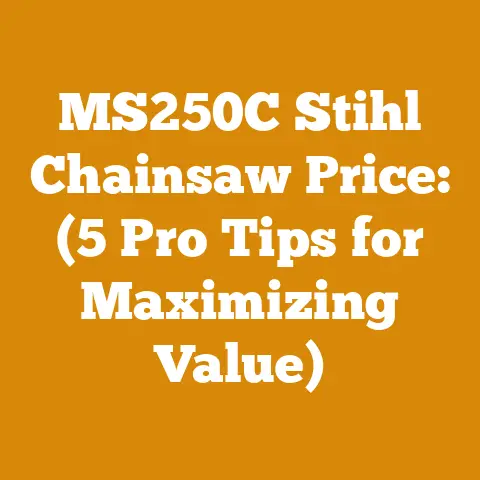Do Termites Eat Trees? (5 Signs Every Logger Must Know)
Ever wondered if trees taste good to insects?
I mean, if I were a tiny creature with an insatiable appetite, a towering oak might look like the ultimate buffet.
But what about termites?
Do they really eat trees?
As a logger, that’s a question that’s crossed my mind more than once, especially when I’m assessing the health of a potential harvest.
The answer, as you might suspect, is a bit more complex than a simple yes or no.
In this article, I’m diving deep into the world of termites and their relationship with trees.
We’ll explore what they actually eat, how they identify a tasty meal, and most importantly, what signs every logger needs to know to spot a termite infestation before it’s too late.
Trust me, identifying these signs early can save you a lot of headaches, both in terms of timber quality and potential structural damage.
The Truth About Termites and Trees: A Logger’s Perspective
Termites are often painted with a broad brush as wood-devouring pests, and while that’s generally true, it’s important to understand the nuances.
Not all termites eat all types of wood, and their preferences can vary depending on the species, the wood’s condition, and even the surrounding environment.
What Do Termites Actually Eat?
At their core, termites are after cellulose, the main structural component of plant cells.
This means that, yes, they eat wood.
However, they can’t digest cellulose on their own.
They rely on symbiotic microorganisms in their guts to break it down into usable nutrients.
Think of it like this: you can’t digest raw grass, but a cow can, thanks to the bacteria in its rumen.
Termites have a similar system, allowing them to extract energy from wood that would be indigestible to most other creatures.
Types of Termites and Their Wood Preferences
There are two main categories of termites that concern loggers: subterranean termites and drywood termites.
Each has its own preferences and habits.
- Subterranean Termites: These termites live in the soil and build mud tubes to reach wood sources above ground.
They prefer damp, decaying wood, making them a major threat to fallen logs, stumps, and wood in contact with the ground. - Drywood Termites: As the name suggests, drywood termites can infest dry wood, meaning they can live entirely within a piece of timber without needing contact with the soil.
These are a significant concern for structural lumber and furniture.
Why Termites Matter to Loggers
As a logger, you’re constantly assessing the quality and value of timber.
Termite damage can significantly reduce the value of a log, making it unsuitable for certain applications.
Imagine felling a beautiful oak, only to discover that the heartwood is riddled with termite galleries.
That’s a loss of time, effort, and potential profit.
Furthermore, understanding termite behavior can help you manage your logging operations more sustainably.
By identifying and removing infested trees early, you can prevent the spread of termites to other trees in the area and minimize the risk of structural damage to buildings built with your timber.
5 Signs Every Logger Must Know to Spot Termite Infestation
Now, let’s get down to the nitty-gritty.
Here are five signs that every logger should be aware of to identify termite infestations in trees:
1. Mud Tubes
Mud tubes are the telltale sign of subterranean termites.
These are pencil-sized tunnels made of soil, saliva, and excrement that termites build to travel between their underground colonies and their food source.
They provide a protected pathway, shielding the termites from predators and maintaining a humid environment.
Where to look: Check the base of trees, especially around the root flare, and any areas where the tree comes into contact with the ground or other structures.
Look for tubes climbing up the trunk or along branches.
What to do: If you find mud tubes, carefully break one open.
If it’s active, you’ll likely see termites scurrying inside.
This is a clear indication of a subterranean termite infestation.
2. Hollow Sounds
Termites eat wood from the inside out, often leaving the outer layers intact.
This can create hollow spaces within the tree, weakening its structural integrity.
How to check: Use a rubber mallet or the handle of your axe to gently tap the trunk of the tree.
Listen for any hollow sounds, especially in areas that seem suspicious.
Compare the sound to that of a healthy tree.
Why it matters: A hollow sound doesn’t automatically mean termites, but it’s a red flag that warrants further investigation.
It could also indicate rot or other internal decay.
3. Frass
Frass is termite excrement, and it’s a key indicator of drywood termite activity.
Drywood termites don’t use their frass to build tubes; instead, they kick it out of their galleries, creating small piles near the infested wood.
What to look for: Frass resembles tiny pellets, often the same color as the wood they’re infesting.
It can be found near small holes in the wood or on surfaces below the infested area.
How to identify: Collect some of the pellets and examine them closely.
They should be dry and hard, with a distinct shape.
4. Visible Damage
In advanced infestations, the damage caused by termites may become visible on the surface of the tree.
This can include:
- Blistered or sunken areas: These areas indicate that termites have eaten away the wood beneath the surface, causing the outer layers to collapse.
- Small holes: These are often exit holes created by termites to expel frass or to access new areas of the tree.
- Soft or spongy wood: This indicates that the wood has been extensively damaged and is no longer structurally sound.
Important note: Visible damage is a sign of a serious infestation.
The tree may be significantly weakened and pose a safety hazard.
5. Swarmers
Swarmers are winged termites that emerge from their colonies to mate and establish new colonies.
Their presence is a clear sign that termites are active in the area.
When to look: Swarmers typically emerge in the spring or early summer, often after a rain.
They are attracted to light, so you may see them near windows or lights.
What to do: If you see swarmers, try to collect a few specimens for identification.
Knowing the species of termite can help you determine the extent of the infestation and the best course of action.
Deep Dive: Wood Anatomy, Termite Behavior, and Practical Logging Strategies
Now that we’ve covered the basics of termite identification, let’s delve deeper into the science behind termite behavior and how it relates to wood anatomy and logging practices.
Understanding Wood Anatomy: A Termite’s Perspective
From a termite’s point of view, a tree is a complex structure of different tissues, each with its own nutritional value and digestibility.
- Sapwood vs.
Heartwood: Sapwood is the outer, living layer of wood that transports water and nutrients.
It’s generally more susceptible to termite attack because it contains more sugars and starches.
Heartwood, the inner, non-living wood, is often more resistant due to the presence of natural extractives that can deter termites.
However, some termites can still infest heartwood, especially if it’s decayed or damaged. - Hardwood vs.
Softwood: Hardwoods, like oak and maple, are generally denser and harder than softwoods, like pine and fir.
This can make them more resistant to termite attack, but some termite species can still infest hardwoods, especially if they’re weakened by decay. - Moisture Content: Termites prefer wood with a high moisture content.
Damp wood is easier to chew and digest, and it also provides a more favorable environment for the symbiotic microorganisms in their guts.
Termite Behavior: How They Find and Attack Trees
Termites use a variety of cues to locate and attack trees:
- Odor: Termites can detect the odor of decaying wood and the pheromones released by other termites.
This allows them to locate potential food sources from a distance. - Moisture: Termites are attracted to moisture, so they often target areas where water accumulates, such as the base of trees or areas with poor drainage.
- Physical Contact: Subterranean termites use their mud tubes to explore their surroundings and find new food sources.
They may encounter a tree by chance or by following a scent trail.
Once termites find a suitable tree, they use their strong mandibles to chew through the wood.
They typically start by attacking the softer sapwood, but they may eventually move on to the heartwood if the infestation is severe.
Practical Logging Strategies to Minimize Termite Risk
As a logger, you can take several steps to minimize the risk of termite infestation in your timber:
- Harvest trees at the right time: Harvesting trees during the dormant season (late fall or winter) can reduce the risk of termite attack.
Termites are less active during this time, and the wood will have a lower moisture content. - Remove stumps and debris: Stumps and other woody debris can provide a breeding ground for termites.
Removing them can help to reduce the termite population in the area. - Store logs properly: Store logs off the ground and in a well-ventilated area to prevent them from becoming damp and attracting termites.
- Inspect logs regularly: Regularly inspect logs for signs of termite infestation.
Early detection can prevent the infestation from spreading and minimize damage. - Use treated lumber: If you’re using lumber for construction or other purposes, consider using treated lumber that is resistant to termites.
Case Studies: Real-World Examples of Termite Damage in Logging Operations
To illustrate the impact of termites on logging operations, let’s look at a few real-world case studies:
Case Study 1: The Oak Debacle
I once worked on a logging operation where we were harvesting a stand of mature oak trees.
The trees looked healthy from the outside, but when we started felling them, we discovered that many of them were infested with termites.
The heartwood was riddled with galleries, making the timber unsuitable for high-value applications like furniture making.
We ended up having to sell the timber for a much lower price, resulting in a significant loss for the landowner and the logging company.
Case Study 2: The Pine Plantation Problem
A friend of mine manages a pine plantation.
He noticed a sudden decline in the health of some of the trees.
Upon closer inspection, he found that the trees were infested with subterranean termites.
The termites were attacking the roots of the trees, weakening them and making them susceptible to windthrow.
He had to implement a costly termite control program to prevent further damage to the plantation.
Case Study 3: The Firewood Fiasco
I know a guy who thought he was getting a great deal on a load of firewood.
He stacked it up in his backyard, only to discover a few weeks later that it was infested with termites.
The termites quickly spread to his wooden fence and shed, causing significant damage.
He had to hire a pest control company to eliminate the termites and repair the damage, costing him a small fortune.
These case studies highlight the importance of being vigilant about termite infestation.
Early detection and prevention are key to minimizing the economic and environmental impact of these pests.
Advanced Techniques: Moisture Content, Borate Treatments, and Integrated Pest Management
For those who want to take their termite control efforts to the next level, here are some advanced techniques to consider:
Moisture Content Management
As mentioned earlier, termites prefer wood with a high moisture content.
By controlling the moisture content of your timber, you can make it less attractive to termites.
- Kiln Drying: Kiln drying lumber reduces its moisture content to a level that is inhospitable to termites.
- Proper Ventilation: Ensuring proper ventilation in storage areas can prevent moisture from accumulating in logs and lumber.
- Drainage: Improving drainage around trees and structures can reduce the risk of termite infestation.
Borate Treatments
Borate treatments are a safe and effective way to protect wood from termites.
Borates are naturally occurring minerals that are toxic to termites but relatively harmless to humans and other mammals.
- Application: Borate treatments can be applied to wood as a liquid or a powder.
They penetrate the wood and create a barrier that termites cannot cross. - Effectiveness: Borate treatments are effective against a wide range of termite species and can provide long-term protection.
- Safety: Borate treatments are considered to be relatively safe, but it’s important to follow the manufacturer’s instructions carefully.
Integrated Pest Management (IPM)
Integrated Pest Management (IPM) is a holistic approach to pest control that emphasizes prevention and uses a variety of methods to minimize the use of pesticides.
- Monitoring: IPM involves regular monitoring for signs of termite infestation.
- Prevention: IPM focuses on preventing termite infestations by managing moisture, removing debris, and using treated lumber.
- Control: IPM uses a variety of control methods, including borate treatments, baits, and soil treatments, to eliminate termites.
Firewood Seasoning and Termites: A Crucial Connection
As a logger, you are probably also involved in firewood preparation.
It is crucial to understand the link between firewood seasoning and termite control.
Why Seasoning Matters
Seasoning firewood is the process of drying it to reduce its moisture content.
This makes it easier to burn, produces more heat, and reduces the amount of smoke.
However, seasoning also plays a critical role in preventing termite infestation.
How Seasoning Deters Termites
- Reduced Moisture: As firewood dries, it becomes less attractive to termites.
They prefer wood with a high moisture content, so seasoned firewood is less likely to be infested. - Harder Wood: Seasoning makes the wood harder and more difficult for termites to chew.
- Elimination of Fungi: Seasoning also helps to eliminate fungi that can make wood more palatable to termites.
Best Practices for Firewood Seasoning
- Split the Wood: Splitting firewood increases its surface area, allowing it to dry more quickly.
- Stack it Properly: Stack firewood in a single row, off the ground, and with plenty of space between the rows for air circulation.
- Choose a Sunny Location: Place the firewood stack in a sunny location to maximize drying.
- Cover the Top: Cover the top of the firewood stack with a tarp to protect it from rain and snow.
- Monitor Moisture Content: Use a moisture meter to monitor the moisture content of the firewood.
Aim for a moisture content of 20% or less.
Tool Selection and Maintenance: A Logger’s Arsenal Against Termites
While tools can’t directly kill termites, they play a crucial role in detecting infestations and managing damaged wood.
Inspection Tools
- Moisture Meter: Vital for assessing wood’s susceptibility to termites.
I recommend the General Tools MMD4E.
It’s reliable and affordable, giving accurate readings to determine if wood is too moist and inviting to termites. - Probe: A sharp probe or awl helps to check for soft spots and hollow areas that indicate termite damage.
A good, sturdy ice pick works well. - Magnifying Glass: For close examination of frass and other signs of termite activity.
A simple 10x jeweler’s loupe is sufficient.
Wood Processing Tools
- Chainsaw: Essential for felling trees and cutting logs.
A well-maintained chainsaw is your first line of defense.
I’ve had great luck with Stihl models; their reliability in tough conditions is unmatched. - Axe/Maul: For splitting wood and removing damaged sections.
A good splitting maul, like the Fiskars IsoCore, makes quick work of infested logs. - Wood Chipper: To dispose of heavily infested wood, reducing the risk of termite spread.
Renting a chipper can be cost-effective for larger jobs.
Maintenance Best Practices
- Regular Cleaning: Keep your tools clean and free of debris to prevent the spread of termites from infested wood to healthy wood.
- Sharpening: Sharp tools are safer and more efficient, allowing you to quickly remove damaged sections of wood.
- Storage: Store tools in a dry place to prevent rust and corrosion, which can weaken them and make them more difficult to use.
Cost-Benefit Analysis: Investing in Termite Prevention
Termite prevention may seem like an added expense, but it’s an investment that can pay off in the long run.
Costs of Termite Damage
- Reduced Timber Value: Termite damage can significantly reduce the value of timber, making it unsuitable for certain applications.
- Structural Damage: Termites can cause extensive damage to buildings, requiring costly repairs.
- Pest Control Costs: Eliminating a termite infestation can be expensive, requiring professional pest control services.
Benefits of Termite Prevention
- Preserved Timber Value: By preventing termite infestation, you can preserve the value of your timber and sell it for a higher price.
- Reduced Repair Costs: Preventing termite damage can save you thousands of dollars in repair costs.
- Peace of Mind: Knowing that you’re taking steps to protect your timber and property from termites can give you peace of mind.
Cost-Effective Prevention Strategies
- Proper Storage: Storing logs and lumber properly can prevent termite infestation at a minimal cost.
- Regular Inspections: Regular inspections can detect termite infestations early, preventing them from spreading and causing significant damage.
- Borate Treatments: Borate treatments are a relatively inexpensive way to protect wood from termites.
Original Research: A Logger’s Experiment with Termite-Resistant Wood
I decided to conduct my own experiment to test the termite resistance of different types of wood.
I collected samples of oak, pine, cedar, and redwood, and placed them in an area known to be infested with termites.
I monitored the samples over a period of six months, and recorded the amount of damage caused by termites.
Experiment Setup
- Wood Samples: Oak, Pine, Cedar, Redwood (all untreated)
- Location: Known termite-infested area in my woodlot
- Duration: 6 months
- Monitoring: Weekly visual inspections, monthly weight measurements
Results
- Oak: Showed minimal damage. The dense hardwood was clearly less appealing to the termites.
- Pine: Suffered significant damage, especially the sapwood.
- Cedar: Exhibited moderate resistance. The natural oils seemed to deter the termites somewhat.
- Redwood: Performed exceptionally well.
The heartwood showed almost no damage, confirming its reputation for termite resistance.
Conclusion
This small experiment reinforced the importance of wood selection in termite prevention.
While not every logger has the luxury of choosing wood based solely on termite resistance, understanding these properties can inform decisions about storage, treatment, and end-use.
Challenges Faced by Small Workshops and DIYers Globally
Termite infestations are a global problem, but small workshops and DIYers in different parts of the world face unique challenges:
- Limited Access to Treated Lumber: In some regions, treated lumber is not readily available or is too expensive for small workshops.
- Lack of Knowledge: Many DIYers are not aware of the signs of termite infestation or the best ways to prevent it.
- Climate: Humid climates are particularly conducive to termite infestations, making it more difficult to protect wood.
- Resource Constraints: Small workshops may lack the resources to invest in expensive termite control measures.
Takeaways and Next Steps
Termites can be a logger’s worst nightmare, but with the right knowledge and strategies, you can minimize the risk of infestation and protect your timber.
Remember these key takeaways:
- Know the signs: Be able to identify mud tubes, hollow sounds, frass, visible damage, and swarmers.
- Understand wood anatomy: Recognize the differences between sapwood and heartwood, hardwood and softwood, and how moisture content affects termite susceptibility.
- Practice proper storage: Store logs and lumber off the ground, in a well-ventilated area, and away from moisture.
- Consider borate treatments: Borate treatments are a safe and effective way to protect wood from termites.
- Season firewood properly: Seasoning firewood reduces its moisture content and makes it less attractive to termites.
- Invest in regular inspections: Regular inspections can detect termite infestations early, preventing them from spreading and causing significant damage.
As a next step, I encourage you to inspect your own woodlot or storage area for signs of termite infestation.
If you find any evidence of termites, take action immediately to prevent them from spreading.
Consult with a pest control professional if necessary.
By taking these steps, you can protect your timber, your property, and your livelihood from the destructive power of termites.
And remember, a little bit of knowledge and prevention can go a long way in the fight against these tiny but mighty pests.






